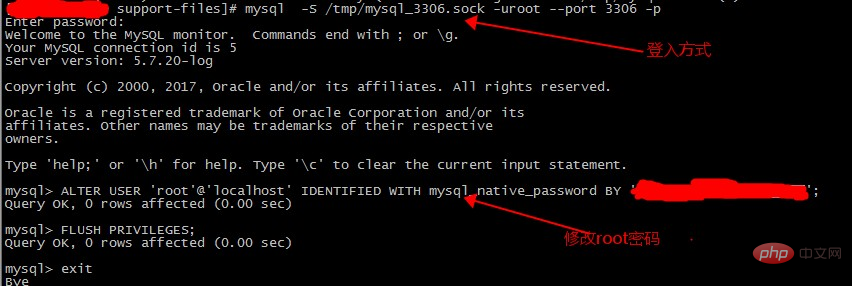
Step 1. Preparation
Close the firewall; install MySQL dependencies Use the libaio library; download, decompress, and rename the MySQL executable file; create new user groups and users and other preparations will not be repeated here.
The executable file directory is /data/mysql57

Instructions for adding users and groups
groupadd mysql useradd mysql -g mysql
Step 2. Add environment variables
In the /etc/profile file, append PATH=${PATH}:/data/mysql57/bin/
After saving, such as To take effect immediately, execute source /etc/profile.
Execute in the data root directory
mkdir -p mysql3306/data mysql3306/mysql_log mysql3306/tmp mysql3307/data mysql3307/mysql_log mysql3307/tmp mysqld_multi/log

This step is essential to create a log file.
touch /data/mysql3306/mysql_log/mysql3306.errtouch /data/mysql3307/mysql_log/mysql3307.err
Give directory and file permissions
chown -R mysql.mysql mysql3* mysqld_multi
In this test case, mysql57 is copied from other services, not downloaded and decompressed directly, so the following two are added Step authorization operation.
chmod -R 755 /data/mysql57/bin
chmod -R 755 /data/mysql57/support-files
step 4. Edit my.cnf
[client] host=localhost socket = /tmp/mysql.sock default-character-set=utf8mb4 #loose-local-infile=0 [mysqld] user=mysql log_bin_trust_function_creators=1 secure_file_priv='/tmp' ########server setting####### sql_mode = "ONLY_FULL_GROUP_BY,STRICT_TRANS_TABLES,NO_ZERO_IN_DATE,NO_ZERO_DATE,ERROR_FOR_DIVISION_BY_ZERO,NO_AUTO_CREATE_USER,NO_ENGINE_SUBSTITUTION" character-set-server=utf8mb4 collation_server=utf8mb4_unicode_ci lower_case_table_names = 0 skip_name_resolve = 1 #max_connect_errors = 1000 max_connections = 2000 thread_cache_size=256 #thread_stack= 262144 #back_log=80 max_allowed_packet = 134217728 event_scheduler = 1 local-infile=0 #lower_case_table_names = 1 explicit_defaults_for_timestamp = 1 expire_logs_days = 7 log_bin_trust_function_creators =1 ####.frm/.ibd files qty related open_files_limit=65535 innodb_open_files=65535 table_open_cache=65535 table_definition_cache=65535 #### seesion buffer related read_buffer_size = 262144 read_rnd_buffer_size = 524288 sort_buffer_size = 8388608 join_buffer_size = 8388608 ####memory table size tmp_table_size =67108864 max_heap_table_size=67108864 ####timeout interactive_timeout = 1800 wait_timeout = 1800 # connect_timeout=10 ########slow query ######## slow_query_log = 1 log_slow_slave_statements = 1 #log_queries_not_using_indexes = 1 log_throttle_queries_not_using_indexes = 10 long_query_time = 1 #min_examined_row_limit = 10000 ########innodb settings######## innodb_buffer_pool_size = 10737418240 innodb_buffer_pool_instances = 16 innodb_buffer_pool_dump_pct = 40 innodb_lru_scan_depth = 2048 innodb_page_cleaners = 16 #innodb_purge_threads = 4 innodb_sort_buffer_size = 67108864 #innodb_file_per_table = 1 #innodb_flush_log_at_trx_commit = 1 innodb_undo_log_truncate = 1 innodb_undo_tablespaces = 3 innodb_max_undo_log_size = 2147483648 innodb_purge_rseg_truncate_frequency = 128 innodb_log_file_size = 1073741824 innodb_log_files_in_group = 3 innodb_log_buffer_size = 16777216 innodb_flush_method = O_DIRECT innodb_flush_neighbors = 0 innodb_print_all_deadlocks = 1 innodb_strict_mode = 1 #innodb_lock_wait_timeout = 50 innodb_io_capacity = 32768 innodb_io_capacity_max = 65536 innodb_thread_concurrency = 32 innodb_write_io_threads = 8 innodb_read_io_threads = 8 ########replication settings######## master_info_repository = TABLE relay_log_info_repository = TABLE gtid_mode = on enforce_gtid_consistency = 1 binlog_gtid_simple_recovery=1 relay_log_recovery = 1 slave-parallel-type = LOGICAL_CLOCK slave-parallel-workers = 16 slave_transaction_retries=128 slave_preserve_commit_order=1 log_slave_updates=1 binlog_format = ROW log_timestamps=system binlog_rows_query_log_events = 1 binlog_row_image='full' slave_skip_errors = ddl_exist_errors ########semi sync replication settings######## ##plugin_dir=/data/mysql/plugin/ #plugin_load = "rpl_semi_sync_master=semisync_master.so;rpl_semi_sync_slave=semisync_slave.so" #rpl_semi_sync_master_enabled = 1 #rpl_semi_sync_master_timeout = 5000 #rpl_semi_sync_slave_enabled = 1 [mysqld_multi] mysqld = /data/mysql57/bin/mysqld_safe mysqladmin = /data/mysql57/bin/mysqladmin log = /data/mysqld_multi/log/mysqld_multi.log [mysqld3306] basedir = /data/mysql57 mysqladmin=mysqladmin datadir=/data/mysql3306/data port=3306 server_id=102473306 socket= /tmp/mysql_3306.sock tmpdir = /data/mysql3306/tmp pid-file = /data/mysql3306/mysql_log/mysql3306.pid slow_query_log_file = /data/mysql3306/mysql_log/mysql3306_slow_new.log log-error = /data/mysql3306/mysql_log/mysql3306.err general_log_file= /data/mysql3306/mysql_log/mysql3306.genlog log-bin = /data/mysql3306/mysql_log/mysql3306_bin relay_log = /data/mysql3306/mysql_log/relay3306.log innodb_buffer_pool_size = 90G innodb_buffer_pool_instances = 8 [mysqld3307] basedir = /data/mysql57 mysqladmin=mysqladmin datadir=/data/mysql3307/data port=3307 server_id=102473307 socket= /tmp/mysql_3307.sock tmpdir = /data/mysql3307/tmp pid-file = /data/mysql3307/mysql_log/mysql3307.pid slow_query_log_file = /data/mysql3307/mysql_log/mysql3307_slow_new.log log-error = /data/mysql3307/mysql_log/mysql3307.err general_log_file= /data/mysql3307/mysql_log/mysql3307.genlog log-bin = /data/mysql3307/mysql_log/mysql3307_bin relay_log = /data/mysql3307/mysql_log/relay3307.log innodb_buffer_pool_size = 90G innodb_buffer_pool_instances = 8 [mysqldump] quick
#step 5. Initialize the instance
Initialize the instance of port 3306, pay attention to the temporary password generated.
/data/mysql57/bin/mysqld --defaults-file=/etc/my.cnf --initialize --user=mysql --basedir=/data/mysql57 --datadir=/data/mysql3306/data
Initialize the instance of port 3307, pay attention to the temporary password generated.
/data/mysql57/bin/mysqld --defaults-file=/etc/my.cnf --initialize --user=mysql --basedir=/data/mysql57 --datadir=/data/mysql3307/data
#step 6. Copy the generated mysqld_multi and add it to the startup
cp /data/mysql57/support-files/mysqld_multi.server /etc/init.d/mysqld_multi
chkconfig --add mysqld_multi
#step 7. Multiple instances of Mysqld Open
Open all instances
mysqld_multi start
View the opening status (view the status of all instances)
mysqld_multi report
Open the specified instance
Open [mysqld3306] in /etc/my.cnf where the number after mysqld is the label, such as the 3306 label
mysqld_multi start 3306
Also open the 3307 label instance
mysqld_multi start 3307
(note: here There is no mention of shutting down the instance through the mysqld_multi stop command. Why not? Because the command is invalid. The operation in Step 9 will make it valid)
Multi-instance login requires specifying the socket parameter
The login method for the 3306 instance in this test is:
mysql -S /tmp/mysql_3306.sock -uroot --port 3306 -p

step 9. Grant permission to shut down the instance through mysqld_multi stop.
To close the instance, you need to configure the root user and password, and modify the /etc/my.cnf file.
Add
user=root password=密码

in the [client] position because the account password needs to be retained in the file, which is a security risk. Whether to set it up like this in the actual environment depends on the specific situation and security requirements.
After the above steps, 2 MySQL instances were successfully installed on this server, one with Port 3306 and the other with Port 3307
##
The above is the detailed content of MySQL multiple instance installation. For more information, please follow other related articles on the PHP Chinese website!